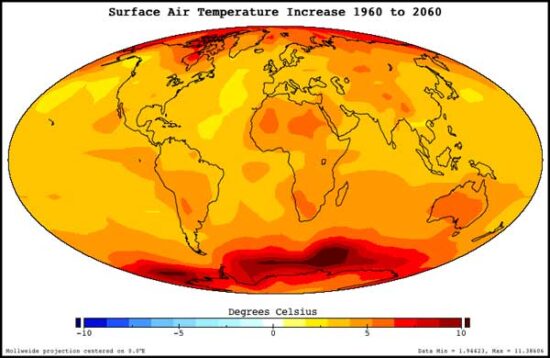
It appears that we are still somewhat in the dark in understanding the implications of adding carbon dioxide (CO2) and other greenhouse gas (GHG) emissions from human activity to our atmosphere. That’s why we continue to develop climate models in abundance to help interpret data and predict the future.
New Climate Study Adds a Previously Unobserved Variable
The latest climate change study published last Thursday supports a conclusion that the southern half of our planet is experiencing storm intensities that models have not previously predicted. The paper published in the May 26th edition of Nature Climate Change describes observed intensification in winter storms in southern mid-latitudes.
The study relies on 30 computer climate change models. I thought about that 30 number and it made me realize that we are still finding our way when it comes to modelling Earth’s changing climate.
Dr. Rei Chemke, is one of the authors of the study. He is a professor at the Department of Earth and Planetary Sciences, at the Weizmann Institute in Rehovot, Israel. His co-authors are Dr. Yi Ming of Princeton University and Dr. Janni Yuval at the Massachusetts Institute of Technology.
In a press release from the Institute, Dr. Chemke describes the importance of studying Southern Hemisphere mid-latitude winter storms. He states, “Individually, each storm doesn’t carry much climatic weight. However, the long-term effect of winter storms becomes evident when assessing cumulative data collected over long periods of time.” Collectively the storms transfer heat and moisture to various climate zones from the equator to the poles. Dr. Chemke points to these storms regulating temperatures at the South Pole because they transfer heat from the tropics poleward. He states, “Without their contribution, the average pole temperatures would be about 30 degrees Celsius lower.”
Why do a study of storms just in the Southern Hemisphere? Dr. Chemke notes that storm intensity increases south of the equator have been greater than those in the Northern Hemisphere. The paper focuses on the physical mechanisms that could explain this changing dynamic.
The authors asked if observed results were being caused by us or part of natural variability within Earth’s systems. They applied the 30 aforementioned climate models to get an answer. What they noted was that the last two decades of observations could not be explained by normal natural climate variations. They also observed that changes to the jet stream were involved with no model able to explain why or able to predict its future track based on what was already being seen.
The paper concluded that current climate models need to be fixed because the implications of the analysis of mid-latitude storm tracks suggest a far worse projection for global conditions and the need for more “rapid and decisive intervention…to halt the climate damage in this region.”
NASA is Big into Climate Models
NASA has been studying climate change since the 1970s. For the most part, the Agency believes global climate models have been fairly accurate. It has done systematic evaluations of the performance of past modelling. One study compared 17 models developed between 1970 and 2007 and showed that 10 of them produced projections that closely matched observed data.
Current models seem to predict temperature, precipitation, sea ice, and summer storm patterns with a high degree of accuracy. But winter storms until this latest study have proven to be unpredictable in terms of climate change consequences.
Why rely on models? The answer is these models simulate atmosphere, land and ocean dynamic interplays. One can use them to go forward or backward in time. One can introduce changing values such as the amount of additional CO2, methane (CH4) or other GHGs humans or nature add to the atmosphere and oceans.
The most effective models to date have predicted changes in air temperature with great accuracy. The least effective have attempted to model air flows like the jet streams found in both hemispheres.
Climate models, despite the challenges to their accuracy, lie behind every IPCC report. Global climate policy decisions made rely on them. The insurance industry employs climate scientists and uses models to help navigate its future.
As climate science has matured, data being fed into climate models has grown exponentially. The scientists looking at climate are no longer just climatologists, meteorologists, oceanographers, or geographers. The Weizmann Institute study comes out of the Physics Department.
Although most of our earliest climate models are functionally obsolete today, the data collected and analyzed remains useful to the next generation of tools being developed. Gavin Schmidt, director of NASA’s Goddard Institute of Space Studies, notes that “as climate model projections have matured, more signals have emerged from the noise of natural variability that allow for retrospective evaluation of other aspects of climate models, for instance, in Arctic sea ice and ocean heat content. But it’s the temperature trends that people still tend to focus on.”
The newly published study in Nature Climate Change has introduced mid-latitude winter storms in the Southern Hemisphere as the latest variable to plug into models. The dramatic changes observed, states Dr. Chemke, call for more dramatic global action to mitigate the warming.








